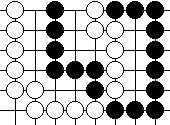
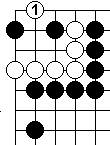

Home > Steve > Go > Problem of the month



Three seki related status questions. For each diagram what is the status - settled or unsettled; live, dead or seki? Use of Richard Hunter's '6 types of fights' liberty counting may be relevant, see the Liberty Counting Table.
Individually, none of the three should be too hard. I have posed
three diagrams to provide variations on a theme.
In diagram B1, White has just played. Black may of course choose to
pass.
Existing literature tends to use 'shared' or 'mutual'
as adjectives when discussing sekis.
Richard Hunter dislikes these because the liberties are not shared, they
are allocated according to the type of fight, and those adjectives can
be misleading. He prefers 'inside'.
'Inside' is fine for No eye Versus No eye fights, but itself becomes
confusing when either party has a eye. There is then a tendency to
consider the eyespace as the inside liberties. I have suggested
'border', but this also has its opponents. I'll stick with
inside for the moment.
To start with Dia A1. This was a shape I discussed with Richard Hunter last year. Although he said he might use it in his series of articles, I was surprised to see it appear in BGJ 111 after posting this problem. Anyway - you get my answer here, read BGJ 111 for Richard Hunter's answer.

Maybe ... Working down the table of fight types in the Liberty Counting Table it looks like a No Eye v
No Eye (2 or more inside liberties) type 2 fight.
So the favourite is the one with more exclusive liberties - Black (6) to
White (4).
So Black gets One inside liberty and White gets All inside liberties. So
Black = 6+1 = 7 and White = 4+4 = 8.
Therefore it is settled, White winning. So White has no need to play and
Black achieves nothing by playing. ... or maybe not.
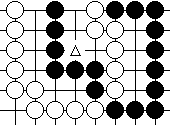
More careful study reveals that ![]() is not a true inside liberty. It is solely
adjacent to Black stones. At this point you have two different
approaches to analysing the situation:
is not a true inside liberty. It is solely
adjacent to Black stones. At this point you have two different
approaches to analysing the situation:
The status is: Black wins.

Dia B1 is from a question posed by Matthew Macfadyen. The answer to his question is to show that an agressive Black gets killed by good white play. We investigate the more subdued and sensible Black moves here.
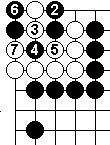
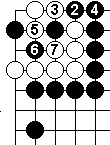
In Dia B2 after White 7, Black is in a fix. If he links under with
8', White captures 4 with 9' and then a Black 10' linking 6 to 2 is out
of liberties.
Thus White gets two eyes (at 4 and 6).
In Dia B3, White gets two eyes directly.
Either way White lives with territory. Therefore the Black would prefer to play for a seki the corner.
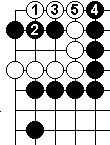
The biggest nakade that Black can build in the corner is the gun shape. When that is done, there will be two 'inside' liberties left. So Black cannot kill White by reducing him to one eye.
Seki analysis: No eye v. No eye, 4 inside liberties, Type 2. White is favourite. White = 1+1 = 2, Black = 0+4 = 4. Black can force a seki.
Back in Dia B1, if it was White's turn to play, he can play as Dia B2 (with Black 2 omitted) and gets life with territory.
The status is: Black can get a seki, White can live with
territory.
It is a gote seki for Black, and a gote white play for about 8 points.
Thus both players are likely to leave the situation for a while, playing
bigger moves elsewhere first.

This is a standard book situation. If you don't know it, you may be wondering where the problem is. It is assumed that the white group is live and that the seki (if any) is between the black stones and white ones yet to be played.
If Black plays first, he can get life with territory.

Starting at the 3-2 point is correct. White can also get a seki by playing 1' at 2 here, but that is gote.
For more details, see page 88 of All about Life and Death (Vol 1) - Cho Chikun.
The status is: Black can get gote territory (7 points), White can manage a sente seki.
Home >
Steve >
Go >
Problem of the month
British Go Association
Last updated 2004-08-10
This page is part of http://www.stocton.org/
Email: webmaster@stocton.org